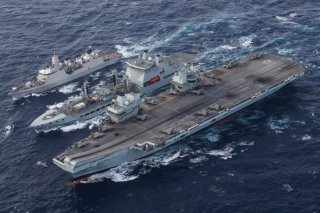HMS Queen Elizabeth to Tour With U.S. and European Navies
The Royal Navy noted that “the aircraft carrier will first deploy to the east coast of the United States to undertake parts of HMS Prince of Wales’ deployment – as her sister ship undergoes repairs.”
Great Britain’s flagship, HMS Queen Elizabeth, is heading across the Atlantic to the United States for exercises with the U.S. Navy, followed by further drills in Europe with other European navies. Though the Royal Navy’s presence in both American and European was long planned, the HMS Queen Elizabeth takes the place of the HMS Prince of Wales, another British aircraft carrier.
In a statement, the Royal Navy explained that “in the coming months, HMS Queen Elizabeth will be at the heart of a powerful task group made up of thousands of sailors, up to ten ships, F-35B Lightning jets, helicopter squadrons and Royal Marines Commandos which will operate across Europe this autumn.”
The statement noted that “the aircraft carrier will first deploy to the east coast of the United States to undertake parts of HMS Prince of Wales’ deployment – as her sister ship undergoes repairs.”
HMS Queen Elizabeth’s Commanding Officer, Capt. Ian Feasey, said: “After a period of maintenance it is fantastic for the Fleet Flagship to be underway again to conduct operational activity with allies and partners.”
Though both the HMS Queen Elizabeth and the HMS Prince of Wales are both very new vessels, the HMS Prince of Wales recently sustained enough damage during exercises that forced the ship back to port.
“Royal Navy divers inspected the starboard shaft and adjacent areas,” said a British Rear Adm. following the carrier’s breakdown. “We can confirm there is significant damage to the shaft and the propeller and some superficial damage to the rudder. There is no damage to the rest of the ship.” The damage was caused by the failure of several of the ship’s propeller and driveshaft components. But, despite the breakdown, the Royal Navy has a backup plan.
“The Royal Navy task force will work closely with allies and partners across Europe – from the Baltic all the way south to the Balkans and Black Sea region – over the coming months,” the Royal Navy said. “The operations are part of galvanised NATO efforts in the face of Russia’s unprovoked invasion of Ukraine to safeguard security, stability and prosperity across Europe.”
It added that the “HMS Queen Elizabeth will primarily be focused on operations in the Baltic and work closely with forces from Denmark, Estonia, Finland, Iceland, Latvia, Lithuania, the Netherlands, Norway and Sweden. Together, these nations form the UK-led Joint Expeditionary Force, which is designed to react to crises whenever and wherever they unfold.”
Despite the ability to substitute the HMS Queen Elizabeth for her sister ship, the HMS Prince of Wales’ breakdown is highly concerning—especially for such a new ship.
Caleb Larson is a multimedia journalist and defense writer with the National Interest. A graduate of UCLA, he also holds a Master of Public Policy and lives in Berlin. He covers the intersection of conflict, security, and technology, focusing on American foreign policy, European security, and German society for both print and radio. Follow him on Twitter @calebmlarson.
Image: Flickr/U.S. Navy.

